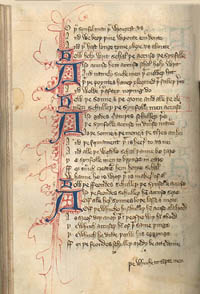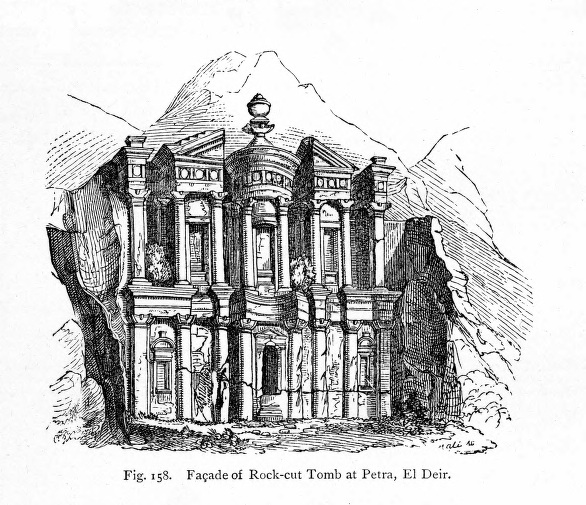 Goal: to read medieval English mystical texts with sensitivity to their literary and cultural contexts in situ, i.e. in Great Britain.
Goal: to read medieval English mystical texts with sensitivity to their literary and cultural contexts in situ, i.e. in Great Britain.
Challenge: to understand the milieu of medieval literature, including the shaping role of medieval Christian culture
Outcomes: Improved reading skills of primary texts: having read and understood primary texts through close reading, discussion, and challenge
Improved reading skills of secondary texts: understanding of, sensitivity to, and work with the primary issues regarding medieval literary texts
Improved writing skills via the production of group-organized and independent written work
Improved position as independent scholar through premier intellectual experience in Oxford
The late fourteenth and early fifteenth centuries witnessed a flourishing of mystical texts, by both men and women, including works by Richard Rolle, Julian of Norwich, and Margery Kempe. Rolle wrote in Latin, but his work was translated into Middle English; both Julian’s and Margery’s works appear in Middle English, as does the anonymous Cloud of Unknowing. In this course we will read these mystical writers and contextualize their writings historically. Besides our primary texts, readings will include background in Middle English language, the Christian mystical tradition, mystical texts in other languages and traditions, and major literary critical statements on Middle English mystics. Course requirements include an introductory paper on a word, a reading log, a film critique, a group presentation with annotated bibliography, and a term paper.
Check out this helpful page about medieval studies research developed by the UO librarians.
Texts: Richard Rolle, The English Writings (Paulist Press, ed Allen); The Book of Margery Kempe (Penguin, ed Windeatt); Julian of Norwich’s Revelations of Divine Love (Penguin, ed Spearing); The Cloud of Unknowing (Shambala Press). Books have been purchased for the program and will be available at CMRS
Requirements
1. A brief exercise in Middle English language
- Choose one word from the following list.
Science Kind Nature Wit
Truth Devotion Affection Imagination
Intention English Simple Understanding
Lewd Bliss Need Bliss
Degree Marvel Simple Meddle
Despair
- Look up the word in the Middle English Compendium. Available on-line at the UO Library: type in "Middle English Compendium" as a title on library home page and click; click on the Website; then click on "Middle English Dictionary"; then click on "look up" to get a field for entering your query.
- Because Middle English spelling is not regularized, you’ll need to use "wildcards" in your search, especially for longer words and words that are derived from Latin (often with a -tion ending). "Wildcard" is an asterisk (*). Generally, replace the vowels with an asterisk, and also put one at the end of your word. For the word "affection," for instance, searching for af*e*n* gives you all words that have those letters in that order, without regard to how many letters are BETWEEN those particular letters. Af*e*n* results in 71 hits, and brings up affeccioun, which is the spelling of the word the Middle English Dictionary uses.
- Write a brief paper (< 1000 words) on the word's subtleties: how do its Middle English definitions fit with modern definitions? What might you anticipate learning about this word in your work for the term?
You can also be the "expert" on your word whenever it seems appropriate for class discussion. You can also highlight your word in your reading log.
2. Reading log. Use pen/pencil in a paper notebook you’ll designate as a reading log of your reactions to/impressions of each day’s reading assignment. Have a companion notebook (electronic is okay), potentially shared with your other coursework, for your class notes. Record dates in notebooks/notes to articulate the relationship between your reading log and other notes. Bring your reading log to every class meeting: you will occasionally be required to share your log entries with others.
3. Movie assignment. We’ll watch Chris Newby’s film The Anchoress and write a short (< 1000 words) paper about it. Choose one of these visual motif groups to organize your essay.
Birds, wings, feathers, nests
Digging, harvest, grain, bread
Water, stone, earth, dirt
Embroidery, paintings, statues
Eggs, milk, apples, pomegranate
4. Working with The Cloud of Unknowing for your term paper bibliography and your group presentation.
You'll arrange yourselves into five groups in order to research and give a short group presentation on an aspect of The Cloud of Unknowing. The topic could be drawn from the list of Middle English words. It could be organized through a topic like mystical/Biblical language, daily life, emotions and/or will, vernacular theology. Each group will (1) compose an annotated group bibliography for their topic, minimum of five academic sources (not just internet research; hard copy of bibliography given, at a minimum, to me), and (2) present for 10 minutes on the aspect they have researched, using The Cloud to provide examples. The purpose of the presentation is to use The Cloud as a way to compare and understand both it, our other texts, and medieval English mysticism. What's the most important thing the rest of the class should know about your group’s research topic regarding Middle English mystics?
Be organized. Do not summarize in detail essays you've read. Each group will be evaluated by the rest of the class as well as by me.
Write down "annotations" for each research article you read. Here are some guidelines for annotation (with thanks to Prof. Lisa Freinkel):
- Cite the article or book chapter using proper MLA documentation style. The UO Library website provides guides to citation forms.
- Do more than summarize the article. Your goal here is to explicate the author's thesis as concisely and clearly as possible. Details of the argument should only be mentioned when they seem necessary for understanding the author's thesis. A good annotation will give a sense of "what's at stake" with the argument. Why is s/he writing this essay? To what critical trend or presumption is s/he responding?
- Occasionally a brief quote will be helpful to convey the author's position or his/her tone, but be careful! You want to explicate, not to re-cite. Be especially careful to paraphrase rather than quote directly if your author is using jargon, specialized or highly theoretical terms.
- Avoid editorializing. Be as neutral as possible. Your goal is not to critique but to explicate and to remember. You are presenting an argument - not demonstrating its weakness.
5. A term paper (2000-3000 words), exploring in depth an aspect of medieval textual mysticism and including work on The Cloud along with at least one of the three Middle English mystics we're reading. Keep close to the texts; find a good, specific thesis; test your ideas with your classmates and with me.
Grading
The Middle English language exercise constitutes 15% of your grade; the group presentation/bibliography, 20%; the term paper, 35%; the Anchoress paper, 15%; contribution, 15%. N.B.: there is no final exam in the class. Please note the University of Oregon’s "grade point value" system effective 9/90, as I will be using this system to grade your work (unless otherwise noted):
|
A+ = 4.3
|
B+ = 3.3
|
C+ = 2.3
|
D+ = 1.3
|
|
A = 4.0
|
B = 3.0
|
C = 2.0
|
D = 1.0
|
|
A- = 3.7
|
B- = 2.7
|
C- = 1.7
|
D- = 0.7
|
Note that a grade of "C" is, according to academic regulations, "satisfactory," while a "B" is "good." That means that a "B" is better than average, better than satisfactory, better than adequate. The average grade, then, is a "C"; a grade of "B" requires effort and accomplishment.



 Goal: to read medieval English mystical texts with sensitivity to their literary and cultural contexts in situ, i.e. in Great Britain.
Goal: to read medieval English mystical texts with sensitivity to their literary and cultural contexts in situ, i.e. in Great Britain.